Do you have a rubber roof? If so, there is a good chance it needs some work. Rubber roofs are great because they last for years without any maintenance. However, eventually, the sun can start to break down the material and cause leaks in your home.
The good news is that repairing a rubber roof isn’t too difficult if you know what to do! In this article, we will show you how to repair a rubber roof with these simple steps.
Gather Your Roof Repair Tools and Materials
The first step in repairing a rubber roof is to make sure you have everything you need. These items should be fairly easy to find around your house, but if not, they can also be purchased at most hardware stores for fairly cheap prices:
- Rubber Roof Repair Kit
- Hammer
- Utility Knife and Replacement Blades
- Metal Ruler/Straight Edge
If you don’t have a rubber roof repair kit, we suggest using any ready-to-use 30 oz. crack and joint sealant with the accompanying crack filling tool.
It works great for smaller issues like cracks or punctures in your rubber roof. Just make sure that if you do order it online, it gets shipped to an address where someone is home during business hours.
Prepare the Surface of the Roof for Repair
If your roof is leaking, you will need to find the source of the leak before it can be repaired. The easiest way to do this is with a water hose and sprayer. Spray all over your rooftop until you see where the water is coming through.
Once you have found the area that needs repair, use sandpaper or an electric grinder (if there are no underlying materials) to rough up the surface around the hole in order for the glue to stick properly.
Clean off any loose dust and debris from sanding so that adhesive has something clean and dry to stick to.
Measure and Cut the Right Sized Patches
After you have cleaned off the area to be repaired, simply cut a patch that is slightly larger than the hole. The size of your rubber roof will determine exactly how big these patches need to be.
When cutting out the patch from new material, it’s best if both pieces are equal in size and shape so they fit together well when applied.
Trim down one side until it slides right into place over the top of where the old piece was removed with no gaps or overlaps (be sure not to trim up too far past where the damage stops).
Prime the Area of Repair and Apply the Patch
After you have prepped and cut your patch, it is time to prime and apply.
Apply a thin coat of rubber roof repair primer to both surfaces using a paintbrush. Let dry for about 30 minutes before proceeding with application steps.
Next, take some seam sealer (the same glue that should already be in your kit) out of its container along with the crack filling tool included with the kit or ordered separately.
You can also use an old credit card or similar plastic object which won’t damage the material being repaired. Place one drop on each corner of your new patch so they will meet flush when applied together over your hole or crack.
Carefully place this piece inside the opening where the old patch was removed.
Use your plastic card or credit card to gently push the corners into place all around (to make sure you don’t leave any gaps between materials).
If there are no cracks in the material, it will be easy for the new adhesives to bond with the existing rubber. However, if this is a punctured hole, use the crack filler tool included in most kits to inject some sealant inside of each corner before trying to apply new glue on top.
This will ensure that both pieces stick together permanently and stay waterproofed from underneath as well. Be careful not to hurt yourself by pressing too hard when using these tools though.
They can give quite easily under pressure if done incorrectly which could lead straight through whatever repair piece you are trying to make.
If you have a larger hole or puncture, use the same process for securing your patch but add more sealant around all of the edges on your new piece before applying it overtop.
Seal the Edges of Your Patches
Use the same method for securing your patch that you did when applying it, to begin with. Use a thin layer of rubber roof repair adhesive around all four edges of the new piece and let it dry overnight before testing its water resistance.
If there is still some moisture coming through after letting everything set up, add another coat or two on top overtop these spots in order to get rid of any leaking issues permanently.
Test Your Rubber Roof Patches
When the new piece has dried overnight, it is time to test its ability to keep water out. Turn on your hose and let it run over the top of whatever repair you have just made.
If there appears to be some moisture coming through, add another coat or two around all four edges for reinforcement purposes until no more leaks are detected. If everything worked properly though, congratulations!
Your rubber roof should now be completely waterproofed again like brand new once repaired with these steps.
Hire a Professional Roofing Contractor
If you are not sure about how to repair a rubber roof yourself, it is best to hire a professional contractor for this job.
They can handle any size of the hole or tear without worrying about an expensive patch kit from the store when they complete your project in record time and with great results.
This will also ensure that everything has been done properly so no further damage occurs over top of what might have already occurred which could result in larger problems down the road.
You can learn more about our services at https://diligentexteriorremodeling.com/roof-replacement-services/.
Want to Learn More About How to Repair a Rubber Roof?
As you can see, it’s not too difficult to learn how to repair a rubber roof. To learn more about this subject, continue reading our blog for more information.










